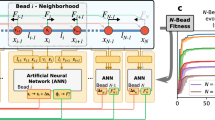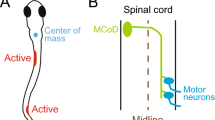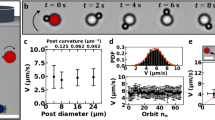Abstract
SWIMMERETS in the crayfish are the paired ventral abdominal appendages which beat in a metachronal rhythm during behaviours such as swimming and burrow ventilation. Each swimmeret is driven by alternating bursts of impulses in antagonistic power- and return-stroke motoneurones. Although proprioceptive input affects the detailed structure of the rhythm, the basic motor programme can be elicited from the deafferented abdominal central nervous system (CNS) by tonic stimulation of single ‘command fibres’ in the ventral nerve cord1–3. Each swimmeret is controlled by a hemiganglion capable of generating the rhythm in isolation, although normally the most posterior swimmeret ganglion (the 5th) acts as a pacemaker, regulating the activity of the other ganglia through a series of coordinating fibres located in the medial region of the ventral nerve cord4. I report here the preliminary results of an investigation into the structure of the central neural oscillator controlling swimmeret movements in crayfish. The results suggest that motoneurones in this system do not act merely as output elements which passively relay the activity of an oscillator formed from pre-motor neurones within the CNS, but that the motoneurones themselves are an integral part of the pattern generating circuits. There is both excitatory and inhibitory central coupling between motoneurones mediated either by electrical or graded chemical synapses. Furthermore, the activity of some motoneurones can directly influence the intensity, period, and phase of the oscillation.
This is a preview of subscription content, access via your institution
Access options
Subscribe to this journal
Receive 51 print issues and online access
$199.00 per year
only $3.90 per issue
Buy this article
- Purchase on SpringerLink
- Instant access to full article PDF
Prices may be subject to local taxes which are calculated during checkout
Similar content being viewed by others
References
Hughes, G. M. & Wiersma, C. A. G. J. exp. Biol. 37, 657–670 (1960).
Ikeda, K. & Wiersma, C. A. G., Comp. Biochem. Physiol. 12, 107–115 (1964).
Wiersma, C. A. G. & Ikeda, K. Comp. Biochem. Physiol. 12, 509–525 (1964).
Stein, P. S. G. J. Neurophysiol, 34, 310–318 (1971).
Davis, W. J. J. Neurophysiol. 34, 274–288 (1971).
Burrows, M. & Siegler, M. V. S. Nature 262, 222–224 (1976).
Author information
Authors and Affiliations
Rights and permissions
About this article
Cite this article
HEITLER, W. Coupled motoneurones are part of the crayfish swimmeret central oscillator. Nature 275, 231–234 (1978). https://doi.org/10.1038/275231a0
Received:
Accepted:
Issue date:
DOI: https://doi.org/10.1038/275231a0
This article is cited by
-
Deep sequencing of transcriptomes from the nervous systems of two decapod crustaceans to characterize genes important for neural circuit function and modulation
BMC Genomics (2016)
-
Premotor nonspiking neurons regulate coupling among motoneurons that innervate overlapping muscle fiber population
Journal of Comparative Physiology A (2009)
-
Rami motor neurons and motor control of the swimmeret system ofHomarus gammarus
Journal of Comparative Physiology A (1987)
-
Neuronal structure and synaptic distribution of a uropod doser motor neuron in the crayfish terminal ganglion
Journal of Neurocytology (1987)
-
Interactions between the motor systems controlling uropod steering and abdominal posture in crayfish
Journal of Comparative Physiology A (1985)



